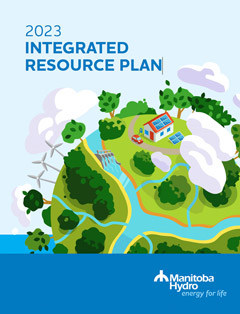Public engagement has begun for Manitoba Hydro’s 2025 Integrated Resource Plan (IRP).
From now until December 19, a survey is available for all Manitobans to share their thoughts on their future energy use and what matters to them when it comes to their energy.
Answers to the survey will help us inform the development of our 2025 IRP, which will help us prepare to continue bringing safe, reliable electricity and natural gas to you in the years to come. The 2025 IRP will include a recommended development plan.
Conducting an engagement survey on this scale (alongside targeted conversations with interested parties) helps ensure our IRP reflects a variety of perspectives from across Manitoba as we work to power the province we call home, now and into the future.
2025 IRP to result in a recommended development plan
“We know from our work on the 2023 IRP that in order to meet future energy needs, we’re going to need to invest,” said Lindsay Melvin, Director of Integrated Resource Planning at Manitoba Hydro. “We also know from our ongoing energy planning that we’re going to need new energy supply as early as 2029. When complete, the 2025 IRP will go a step further and outline how we meet those future energy needs across both our electricity and natural gas systems.”
To that end, Lindsay Melvin says the development plan, which will be an outcome of our 2025 IRP, will account for many options and variables as it outlines the steps needed to meet future energy needs.
“The IRP focuses on the long-term energy needs of Manitoba as a whole,” said Lindsay Hunter, Manager of IRP Policy & Coordination at Manitoba Hydro. “This means we’re typically looking at utility-scale resources to balance Manitoba’s supply and demand needs, how the electricity and natural gas systems support each other, and what we may need to invest.”
Examples of the utility-scale resources being considered in the planning process include wind, hydroelectricity, natural gas, renewable natural gas, hydrogen, and energy storage.
“As we work through our planning process, it’s equally important that we consider programs for reducing demand at peak times and other methods for saving energy or optimizing our energy systems – for example, dual-fuel heating (a combination of a natural gas furnace and an electric heat pump),” said Hunter.
Planning for our energy future – an ongoing process
Manitoba Hydro identified the need for investments in its 2023 IRP, which studied how the energy transition could impact our natural gas and electricity systems from generation to transmission to distribution.
2023 Integrated Resource Plan
- Download the 2023 Integrated Resource Plan (PDF, 12 MB)
The utility monitors the pace of energy transition, keeping tabs on the ways energy use is changing and the speed at which demand for energy will grow against our ability to supply it.
And we continue to monitor the pace of change by watching for signposts like government actions, market forces, and customer decisions. Watching these signposts for any changes and understanding how they may impact our energy future helps us with energy planning, ensuring we have as much information as possible to inform our long-term plans.
Integrated Resource Planning: the steps to success
The 2025 IRP involves a number of steps including:
- public engagement with customers and interested parties, helping to inform our planning;
- information gathering and data analysis;
- modelling potential energy futures; and
- analyzing potential development plans.
After those steps are complete, Manitoba Hydro can determine the recommended development plan.
Following the release of our development plan – estimated to be completed in fall 2025 – Manitoba Hydro will start putting that plan into action.
“There’s a long road ahead to completing our development plan, and after it’s released, we’ll have to implement it,” said Lindsay Melvin. “That could potentially mean building new resources and finding new or other ways to meet Manitoba’s energy needs, as well as developing and modifying further plans as we go.
“Developing an IRP is an iterative process – we’ll continue to work to understand the changing energy landscape in the 2025 and all subsequent IRPs.
“It’s an ongoing journey, but it’s critical to ensuring we navigate the coming years successfully and continue serving Manitobans with the safe, reliable energy they expect from Manitoba Hydro.”



